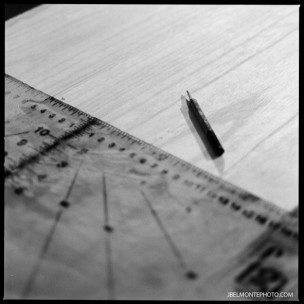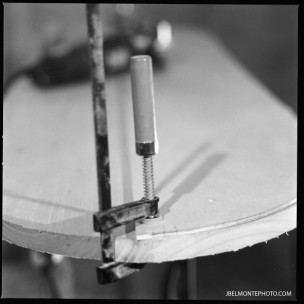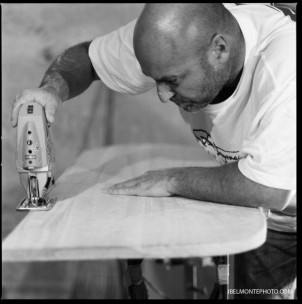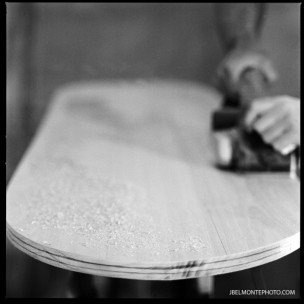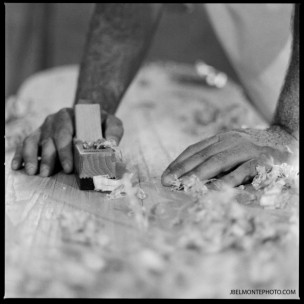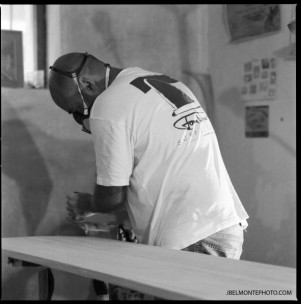A Paipo
Interview with Salvador (Salva) Artaza Aristondo
November 15 to November 23, 2011. Getxo, Spain.
E-mail interview and questions by Bob Green
Salvador Artaza Aristondo (Salva) began riding wooden
plankings around
Bilbao, on the Basque coast of Spain. In more recent years he has
returned to riding wooden boards -- this time the alaia. He recalls some of
those early surfing days and discusses making and surfing
alaia. Around San Sebastian (Donostia), plankings are known as txampero
(meaning "the gadget that allows someone to take advantage of the strength and
movement of a wave, to ride it"). And, in the Asturias, plankings were known as corre olas (meaning "wave
runner") (see Note 1). In addition to Salva's account, the stories of other local surfers have
been included, such as Julito "Copa Davis" and Nacho Susaeta.
|
1. Was a
planky your first
experience of surfing? Do you recall where your planky came from?
Yes, it was a birthday present from my uncle
Avelino.
So how old were at the time?
I was seven years old. This was 1975. When my uncle Avelino gave me
my planking I was a bit disappointed. Only now after many years of
surfing I do understand planking a bit more.
Salva, 2010.
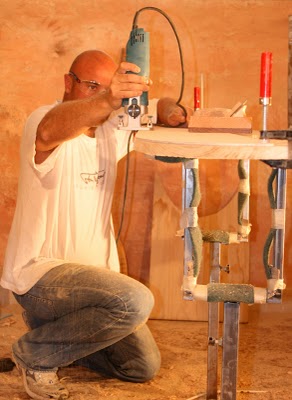
Photo by Jesús Belmonte "Sancheski." (See Belmonte's web site at
http://www.jbelmontephoto.com/.)
2. What do you recall of the boards and their dimensions?
Plankings had varnish on the bottom and stones
would scratch
the board. The tails were square but some had a swallow tail. I think, if I
also surfed EPS with no-glass surfboard, they would break standing up.
We also used to make skegs from metraquilato (methacrylate) a transparent material,
easy to cut and shape. They where attached to plankings using "L" and
screws. I remember shaping a pair of twin fins for a friend named
Eduardo Argaluza, but they never hit the water.
Was your board decorated?
No.
3. Where did you ride your planky and what sort of wave
were they suited to?
At Salvaje Beach, in all kind of conditions,
from flat waves (e.g., skimboarding) to
large waves.
What technique was used to ride larger waves, for example, to
make steep takeoffs and get speed?
Use legs as fins.
I had no flippers. The lifeguards did not let people ride plankys
without flippers in large swells. A friend of mine, Javier Miguez
Azpiazu, was surfing La Corriente at Salvaje Beach one day with me. It
was big, Javi had no flippers. I was riding my Genesis red singlefin
and the lifeguard with flippers, came swiming with the current, yelled
at Javi, threw his planking away from him and told Javi to go to shore.
4. It is quite difficult to catch waves without
swimfins, what technique was used to get out the back and catch waves
when you didn't use swim fins?
Mixed paddle and kick, more kick than paddle I
suppose.
5. Could you angle and turn the boards or would they
basically be
ridden straight to shore? What technique was involved in riding one of
these boards?
They could be turned, cut back, using legs as
fins. We also did 360s.
6. You mentioned in an e-mail that one of your friends
could ride
his planky standing up. Who was your friend and how did he surf the
board?
Mario Ruiz could ride prone, dropknee and
standing up.
Did Mario Ruiz have a role model or did he just
experiment with these different surfing styles? When was this?
Mario and I went to the same classroom. He used to surf Bakio. He was
skinny, so standing up on a bodyboard was easy for him. He experimented
with different styles.
7. I believe you have spoken to some of the early
surfers in your area about "planking." Who have you spoken with?
Recently I met Josean Ariño (the last
plankinero in Bizkaia) and
asked him about planking. The ones with no logos came in three sizes:
small, medium and large. The best brand for him were "Tiburon," also the
largest and most expensive (500 pesetas). Josean attached skegs to the
board for better gripping to the waves. I did not ask him where he surfed but it was
probably Ereaga or Salvaje beach. He told me that Borja de la Quintana
used to ride planking too.
Tiburon planky.
|
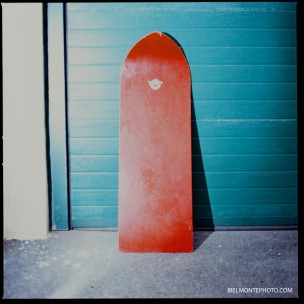
|
|
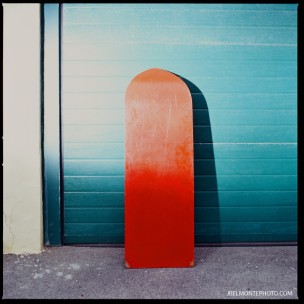
|
Tiburon logo
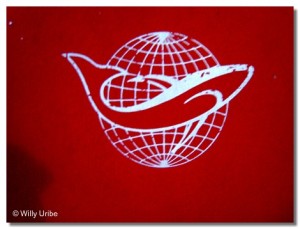
Photos by Jesús Belmonte "Sancheski."
Another area planky rider was Nacho Susaeta, born in 1967. The first
time he saw a surfboard was in Mundaka when he was around 10-years-old.
His parents bought him a planking like the Tiburon board. He surfed
this board at Laida Beach (a beach in front of Mundaka, sited in the Urdaibai
Natural Reserve, on the other side of the rivermouth). The boards were
sold in traditional sports shops as there were no surfshops at the
time. Nacho later shared a surfboard and a wetsuit with two or three
friends and "forgot about prone surfing." Around the age of 30, he
returned to surfing on a longboard. After seeing Tom Wegener surfing
prone, Nacho thought he'd try an alaia. He writes, "... the sensations I
found with my Pinocchio were great!!! We put names to every board we
ride, and as it is a soulful wooden creature I called it Pinocchio,
like the wooden puppet." Continuing, "A couple of years ago in garbage close
to our office we found a planking that was exactly the same as I used
to ride when I was a kid." Nacho noted that "many of the plankings used
to have corners on the tail, but I remember that the next generation of
them had round corners on the tail in order to avoid accidents for the
kids." (Nacho Susaeta, personal e-mail, December 9 and 13, 2011.) For more on Nacho, see Note 2.
There is another man in my area, we call him Julito "Copa Davis." He was
one of the first surfers here. He owned a store in Neguri and used to
sell swimming pool chlorine, beach rackets and plankys.
What does "Copa Davis" mean?
"Copa Davis" means "Davis Cup." I don't know the origin of the nickname.
He could have played the Cup. I think that people call him Julito
"Copa Davis" because he is as old as the cup. I will ask him.
8. What was your age when you stopped riding these boards and
when did they generally stop being ridden in Spain?
I was 15. 1980.
Was this when you got your first stand-up board?
Yes, It was a single fin with channels, red tinted pin line,
second-hand bought from Alfonso Escudero. It had an Aleeda sticker
glued at the
bottom, Alfonso was the glasser at Genesis Surfboards. I also bought my
first wetsuit there, a thin O'Neill.
What sparked your interest to start start stand-up
surfing?
I saw people surfing at La Salvaje. I had also seen surfing
photographs, they where cut off from surfing magazines, lefthanders,
classic single fin rides.
9. How did you become interested in riding and making
alaia?
I saw them in a 2008 Glide magazine. On
the cover Chris del Moro was
holding an alaia. A friend of mine, Yusepe, wanted an alaia, asked me to
buy one for
him. I saw the magazine article and I was stoked with surfing again. I
searched the net and found Tom Wegener, mailed him and we made a deal... the
rest of the story is written here: http://alaia-surf.blogspot.com/2008/12/origenes-del-movimiento-alaia-moderno.html
A work in
progress - Salva Artaza and alaia
|

|
|
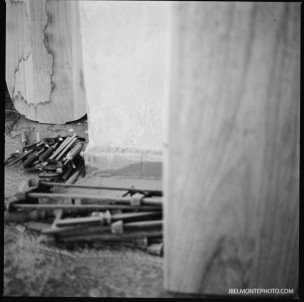
|
Photos by Jesús Belmonte "Sancheski."
10. What types of boards do you make - are these mostly
ridden stand-up or prone?
I make all kind of boards, from handplanes to
longer boards.
Alaias and a
handplane
|
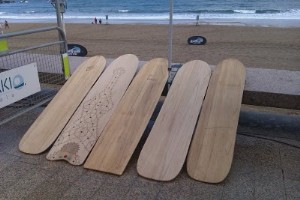
Photos courtesy of
Salva Artaza.
|
|
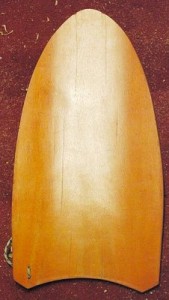
|
|
11. What types of waves are they made for?
All kind of waves.
Nacho Susaeta, taking off late.
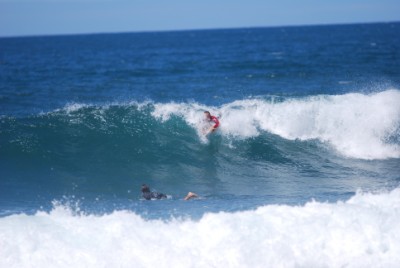
Photo courtesy of Salva Artaza.
12. What do you enjoy about the alaia? Any waves or
surfs stand out for you that you have ridden on an alaia?
Shaping, riding small waves and watching
people surf them.
Salva, Salinas Longboard
Festival.
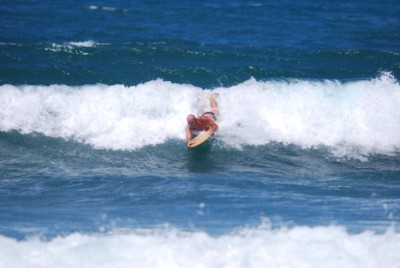
Photo courtesy of Salva Artaza.
13. What is the reaction in Spain to the alaia?
Some like them, some don't.
Locals enjoying
alaia - Asier (2011) and Jon Amiano (2009).
|
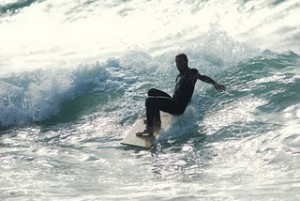
|
|
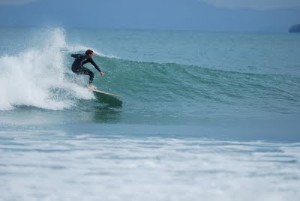
|
Photos courtesy of Salva Artaza.
|
14. If you were to build an alaia to be ridden prone,
what
dimensions would it be and what would the board be like? Would it be
made of
paulownia or do you use different woods?
Most of my boards use Tom's templates but I make
them wider than his
boards. Basically it is a Finley, much wider and with a mermaid tail. This
oversized boards we call the Tibet model. Asier is riding the Tibet
model, the idea of this board was a beginer board, but he likes it as
an advanced model, too. Flex is very important -- light riders need more
flex than heavy riders.
Artaza alaia
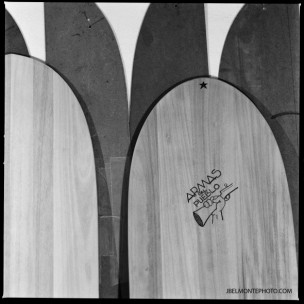
Photo by Jesús Belmonte "Sancheski."
A 6'6'' so you can use it prone or stand-up, unless you like paipo
style with flippers... this one could be shorter than 6'6''... let say
5' or less, width is variable from narrow boards to wide ones.
Paulownia is the best wood I have tried, and Tom Wegener's blanks are
the best by far. There are no magic shapes, it all depends on the
rider, the type of waves to be ridden, and the personal interpretation
of the rider and their style.
Alaia templates
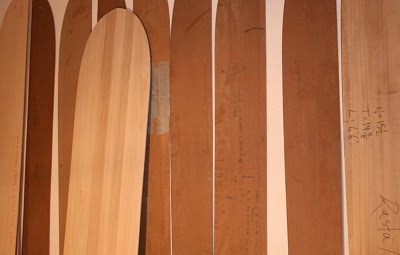
Photo courtesy of Salva Artaza.
15. What technique is involved in riding an alaia prone?
Paddle, kick, turn, ride... slow down... run...
Question
posed to Nacho Susaeta: What technique is involved in riding an alaia
prone and how does riding an alaia differ from riding a planky?
The difference between riding alaias and plankings is that the alaias
are perfect crafts, like pieces of engineering that work perfectly for
a specific task, more technical, simple but complicate. One can
understand that they have been there since ages without changing
because they work. That's what Tom rediscovered for all the modern
surfing community -- the perfection of simplicity. Plankings are just
combined pieces of wood for the kids to play with in the waves (and that's
the BIG secret, having fun!!). And they can be really fun!! (Nacho Susaeta, personal e-mail,
December 13, 2011.)
16. As a stand-up surfer what do you enjoy about riding
an alaia prone?
Speed.
Salva heading out.
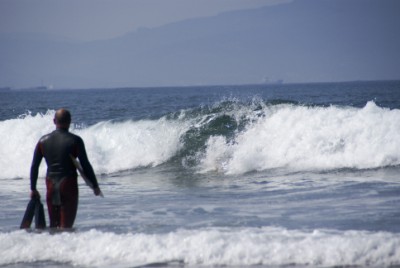
Photo courtesy of Salva Artaza.
Note 1:
Sergio Gonzalez Alonso of Sublime Surf Machines
advised that plankings were called "corre olas" while Javier Arteche
provided the explanation of the word txampero (see the Paipo Interview with Arteche, at http://mypaipoboards.org/interviews/JavierArteche/JavierArteche_2012-0114.shtml).
Note 2:
For more of Nacho's story, see Question 15 and Oficina de Hechos
(see Note 3).
Note 3: Several web sites of interest
- Oficina de
Hechos is a joint project by Luis Tejerina and Nacho Susaeta. Nacho wrote, "Luis Tejerina is a great surfer and poet. A friend of
ours, Unai Azkune, is the author of many of the songs we use as
soundtrack in our videos. He is also a great painter, a total artist." Visit the web site: http://oficinadehechos.blogspot.com/
|
|






